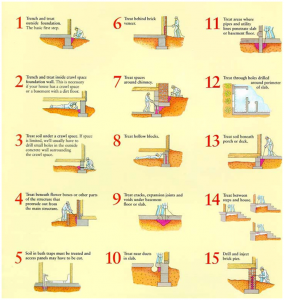
SOIL TREATMENTS
Post Construction Treatment or Soil Treatment
Your home is likely to be the most expensive purchase you’ll ever make. Of course, the destruction brought on by termites can ruin your investment. That’s why you need to take steps to prevent it from happening.
Termites are a natural part of the environment. They serve as beneficial feeders of cellulose (a substance we use in news print), aiding in the decomposition of leaves and wood, which are continuously recycled in nature. It is when termites invade human structures that their role changes from beneficial to destructive.
Central Termite and Pest Control offers very effective termite control methods to protect your home or business. Our pest control professionals will provide an evaluation or your property and issue the proper recommendation to protect your investment.
How to Choose Subterranean Termite Treatment for Your Home
Liquid termiticides are popular materials used for subterranean termite control. There are two general types of liquid termiticides used to treat termites around homes. Repellent products and the newer non-repellent products.
Types of Liquid Termiticides
Repellent Termiticides
Prior to 2002, liquid termiticides often were applied in a similar manner. There was a lot of drilling both under your home and outside along the foundation.These techniques sought to create a repellent barrier in the soil to prevent termites from entering a home.
A repellent barrier treatment requires extensive drilling through slabs and foundation walls in order to reach and treat vulnerable areas in the soil where termites may enter.
The problem to this type of treatment is that some termite entry points may be difficult to find and even the smallest gap in the barrier can allow termites to enter and have the chance to damage a home.
These repellent termiticide treatments have virtually no effect on termite populations near a home. Repellent termiticides are designed to control only those termites who in come into direct contact with the product.
Non-Repellent Termiticides
The newer non-repellent termiticides have a different mechanism to control termites. Termites cannot detect soil treated with a non-repellent termiticide. Instead, they tunnel into a treatment zone, unaware that they are coming into contact with the treated soil.
Gaps in treatment application are less of a problem with non-repellent termiticides compared to repellent termiticides. In addition, some of the new non-repellent termiticides can be transferred from termites that have come into contact with the treatment. The result of this transfer effect is control of more termites than just those that enter a treatment area.
Baiting
Termite baits consist of paper, cardboard, or other acceptable termite food, combined with a slow-acting substance lethal to termites. If the bait kills too quickly, sick or dead termites may accumulate in the vicinity of the bait stations, increasing the chance of avoidance by other termites in the area. Delayed-action or slow-acting bait also enhances transmission of the lethal agent to other termites, including those that never fed on the bait.
Some bait stations are installed below ground out in the yard, and others are positioned within the structure in the vicinity of active termite mud tubes or feeding sites. Below-ground stations typically contain untreated wood until termite activity is detected inside the stations. Then the wood is replaced with active ingredient treated material-the bait itself on.
Termite Entry Points and Treatments

Pre-Construction Anti-Termites Treatment
For the purpose of this standard, the following definitions shall be applied. Soil treatment- this is a process in which soil treatment is applied to a building during the early stages of its construction.
1- Vertical surface: treatment after the masonry foundation and the retaining walls of the basement come up to ground level.
2- Horizontal surface: treatment to top of the soil below ground slab level.
3- Around building at ground level: treatment.

Post-Construction Anti-Termites Treatment
EVIDENCE OF TERMITES INFESTATION
1- Galleries in wood: Wood damaged by termites has galleries that tend to run with the grain.
Although some will cross the grain, these galleries can be distinguished from similar damage caused by other wood infestation insects because they usually contain soil particles instead of sawdust.
2- Mud Tubes: Are also evidence of infestation.
When termites cross concrete and similar surfaces to reach wood, they construct these tubes as a shelter. The tubes are made of soil particles cemented together with saliva and excreted fluid waste.
3- Soil Passages:
Termites feed on wood and cellulose materials, but they also need constant moisture to survive. Colonies usually nest in the soil which provides that moisture.
4- Moist Wood:
Wood which is in direct contact with the soil such as under a dirt filled porch, provides the ideal condition for termites.
 Little Rock, AR 501-868-3837 | Russellville, AR 479-968-4777 | Hot Springs, AR 501-442-5653 | Fayetteville, AR 479-899-6874
Little Rock, AR 501-868-3837 | Russellville, AR 479-968-4777 | Hot Springs, AR 501-442-5653 | Fayetteville, AR 479-899-6874

